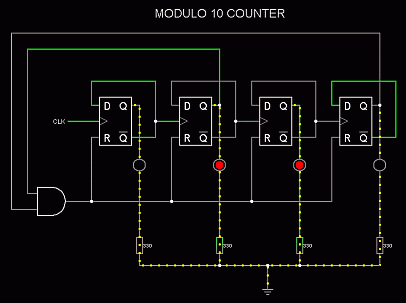Modulo Operator in CC with Examples. Counts the values in ascending order.

Modulus Of The Counter Counting Up To Particular Value Youtube
Two numbers a and b are said to be congruent modulo n when their difference a - b is integrally divisible by n so a - b is a multiple of n.

Modulo n counter meaning. This is because the most significant flip-flop the furthest flip-flop from the original clock pulse produces one pulse for every n pulses at the clock input of the least significant flip-flop the one triggers by the clock. Its output frequency is fN. The synchronous counter is a type of counter in which the clock signal is simultaneously provided to each flip-flop present in the counter circuitMore specifically we can say that each flip-flop is triggered in synchronism with the clock input.
The 2-bit ripple counter is called as MOD-4 counter and 3-bit ripple counter is called as MOD-8 counter. Modulo n counter anoopjose A mod N counter is a counter that has N states. The number of states or counting sequences through which a particular counter advances before returning.
The modulo division operator produces the remainder of an integer division. Modulo is a math operation that finds the remainder when one integer is divided by another. So in general an n-bit ripple counter is called as modulo-N counter.
Counters are generally classified as either synchronous or asynchronous. In Python the modulo operator works as follows. There are three types of modulus counter 2-bit up or down MOD-4.
The clock input is given to the first flip-flop. A mod-n counter may also be described as a divide-by-n counter. Counts the values in.
In writing it is frequently abbreviated as mod or represented by the symbol. The number of states that a counter owns is known as its mod modulo number. Mod-n Synchronous Counter A Mod-n Synchronous can be implemented using appropriate number of J-K flip-flops connected together with their clocks triggered simultaneously.
Congruence Modular Arithmetic 3 ways to interpret a b mod n Number theory discrete math how to solve congruence Join our channel membership for. A mod b r. Unlike asynchronous counter where separate clock pulses are used to trigger the flip-flop all the flip-flops in synchronous counters are.
The numbers are first converted in the common type. An n-MOD ripple counter contains n number of flip-flops and the circuit can count up to 2 n values before it resets itself to the initial value. Modulo N Up Counter This is a counter that resets at a chosen number.
Most common type of counter is sequential digital. A b mod n and n is called the modulus of a congruence. When we divide two integers we will have an equation that looks like the following.
Sometimes we are only interested in what the remainder is when we divide by. The number of flip-flops used determine the modulus of the counter wherein the number of flip-flops depend upon the number of logic states in the counter before it reaches its initial state. The modulus of a counter is given as.
Where MOD number 2n. For a Modulo n counter the clock input to the nth flip-flop is determined by the n-1th flip-flop output. If a MOD-10 counter counts 10 states 0000 -.
11 mod 4 3 because 11 divides by 4 twice with 3 remaining. If x and y are integers then the expression. A counter is a device which can count any particular event on the basis of how many times the particular event s is occurred.
For these cases there is an operator called the modulo operator abbreviated as mod. In a digital logic system or computers this counter can count and store the number of time any particular event or process have occurred depending on a clock signal. For example a two digit decimal counter left to its own devices will count from 00 to 99.
Take a step-up from those Hello World programs. Mathematically the modulo congruence formula is written as. The symbol used to get the modulo is percentage mark ie.
In Python and generally speaking the modulo or modulus is referred to the remainder from the division of the first argument to the second. Where a is the dividend b is the divisor or modulus and r is the remainder. Hence a 3-bit counter is a mod-8 counter.
A modulo N counter does the same thing as above and is also used as an alternate definition which implies that the counter counts N states. The modulo operator denoted by is an arithmetic operator. 178 rows In computing the modulo operation returns the remainder or signed remainder of a division.
The Modulus or MOD-number of a counter is the total number of unique states it passes through in one complete counting cycle with a mod-n counter being described also as a divide-by-n counter. For two integers a and b. The maximum possible modulus is determined by the number of flip-flops.
For example a four-bit counter can have a modulus of up to 16 24. The modulus of a counter is the number of states in its count sequence. Counters are sequential logic devices that follow a predetermined sequence of counting states triggered by an external clock CLK signal.
Alternately you can say that a and b are said to be congruent modulo n when they both have the same remainder when divided by n. 2 n where n number of flip-flops. These counters can count in different ways based on their circuitry.
For example a simple 4 bit binary counter is a mod 16 counter. An Introduction to Modular Math.

Mod Counters Are Truncated Modulus Counters

Mod Counters Are Truncated Modulus Counters
